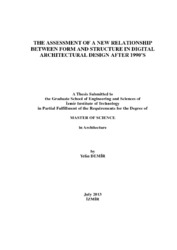Please use this identifier to cite or link to this item:
https://hdl.handle.net/11147/3624Full metadata record
| DC Field | Value | Language |
|---|---|---|
| dc.contributor.advisor | İnceköse, Ülkü | en |
| dc.contributor.author | Demir, Yelin | - |
| dc.date.accessioned | 2014-07-22T13:51:58Z | - |
| dc.date.available | 2014-07-22T13:51:58Z | - |
| dc.date.issued | 2013-07 | en |
| dc.identifier.uri | http://hdl.handle.net/11147/3624 | - |
| dc.description | Thesis (Master)--İzmir Institute of Technology, Architecture, İzmir, 2013 | en |
| dc.description | Includes bibliographical references (leaves: 137-146) | en |
| dc.description | Text in English; Abstract: Turkish and English | en |
| dc.description | xiv, 146 leaves | en |
| dc.description | Full text release delayed at author's request until 2015.08.02 | en |
| dc.description.abstract | From the beginning of 1960’s, architects are using computers in architectural design processes. Initially, architects used them as design tools for representation and modelling purposes. However from the beginning of 1990’s, architects started to use computers as design mediums where the whole design process evolves starting from design ideation to construction. Digital technologies enabled architects to design wide range of forms in digital design environments and therefore, form-based design processes appeared. Architects mostly focused on form generation concerns. However, this form based approach brought forth problems in relation to constructability. Complex irregular forms challenged engineers to find optimal structural solutions. Architects and engineers started to work on a unified architectural and structural design process and offered new structural system solutions with the help of digital technologies for overcoming the constructability problem. This process and solutions presented different form-structure relationships. The main aim of this thesis is to reveal the form-structure relationships in digital design processes focusing on constructability of digitally designed forms. Constructability is related to structural system design. Therefore, this thesis examines design, manufacturing and construction processes of structural systems to understand how architectural designs/forms are realized and constructed. It examines the whole process of design to construction of structural systems including models, tools, structural system solutions, and fabrication and construction methods. The examination is done over case studies which are digitally designed and constructed building examples. Each case study exemplifies a different model, tool, structural system and design process which also defines a different type of form-structure relationship. Key words: digital architectural design, structural design, form, structure, construction | en |
| dc.language.iso | en | en_US |
| dc.publisher | Izmir Institute of Technology | en_US |
| dc.rights | info:eu-repo/semantics/openAccess | en_US |
| dc.subject.lcsh | Architectural design--Data processing | en |
| dc.subject.lcsh | Architectural drawing--Computer-aided design | en |
| dc.subject.lcsh | Structural design | en |
| dc.title | The assessment of a new relationship between from and structure in digital architectural design affter 1990's | en_US |
| dc.type | Master Thesis | en_US |
| dc.institutionauthor | Demir, Yelin | - |
| dc.department | Thesis (Master)--İzmir Institute of Technology, Architecture | en_US |
| dc.relation.publicationcategory | Tez | en_US |
| item.fulltext | With Fulltext | - |
| item.grantfulltext | open | - |
| item.languageiso639-1 | en | - |
| item.openairecristype | http://purl.org/coar/resource_type/c_18cf | - |
| item.cerifentitytype | Publications | - |
| item.openairetype | Master Thesis | - |
| Appears in Collections: | Master Degree / Yüksek Lisans Tezleri | |
Files in This Item:
| File | Description | Size | Format | |
|---|---|---|---|---|
| 10011455.pdf | MasterThesis | 7.24 MB | Adobe PDF |  View/Open |
CORE Recommender
Page view(s)
170
checked on Nov 18, 2024
Download(s)
160
checked on Nov 18, 2024
Google ScholarTM
Check
Items in GCRIS Repository are protected by copyright, with all rights reserved, unless otherwise indicated.